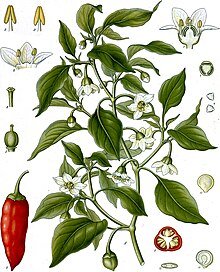Capsicum annuum
| Capsicum annuum | |
|---|---|
 |
|
| Scientific classification | |
| Kingdom: | Plantae |
| (unranked): | Angiosperms |
| (unranked): | Eudicots |
| (unranked): | Asterids |
| Order: | Solanales |
| Family: | Solanaceae |
| Genus: | Capsicum |
| Species: | C. annuum |
| Binomial name | |
|
Capsicum annuum L. |
|
| Varieties | |
|
|
| Synonyms | |
|
|
Capsicum annuum is a species of the plant genus Capsicum native to southern North America and northern South America. This species is the most common and extensively cultivated of the five domesticated capsicums. The species encompasses a wide variety of shapes and sizes of peppers, both mild and hot, ranging from bell peppers to chili peppers. Cultivars are descended from the wild American bird pepper still found in warmer regions of the Americas. In the past some woody forms of this species have been called C. frutescens, but the features that were used to distinguish those forms appear in many populations of C. annuum and it is not a consistently recognizable feature in C. frutescens species. Moreover, crosses between C.annuum and C. frutescens aren't likely because seeds obtained from polliations between those two species (if the embryo survives) will not germinate.
Although the species name annuum means “annual” (from the Latin annus “year”), the plant is not an annual and in the absence of winter frosts can survive several seasons and grow into a large perennial shrub. The single flowers are an off-white (sometimes purplish) color while the stem is densely branched and up to 60 centimetres (24 in) tall. The fruit are berries that may be green, yellow or red when ripe. While the species can tolerate most climates, C. annuum is especially productive in warm and dry climates.
The species is a source of popular sweet peppers and hot chilis with numerous varieties cultivated all around the world.
Common naming in English falls generally in line with the flavor and size of the variant. Larger, sweeter variants are called sweet peppers in Great Britain, and red or green peppers,or "bell peppers" in the United States. The smaller, hotter varieties are called chillis, chilies, chile, or chili peppers.
Capsinoid chemicals provide the distinctive tastes in C. annuum variants. In particular, capsaicin creates a burning sensation ("hotness"), which in extreme cases can last for several hours after ingestion. A measurement called the Scoville scale has been created to describe the hotness of peppers and other foods.
...
Wikipedia
